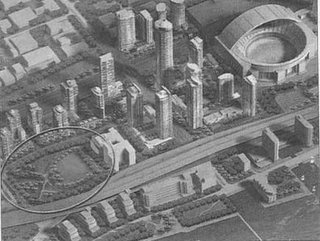Railway Lands Update – Landscape Architecture Against the Ropes?

For a while it’s seemed like Landscape Architects have been increasingly relegated to subservient roles in many areas of their work outside of their core discipline of designing and overseeing construction of built landscapes. Sometimes, hard as it can be to admit, willingness to accept these roles has become a justification for this trend – references to Landscape Architects as simply putting trees and green on plans are saddening largely because of how frequently they are true. However, recent events in the Railway Lands in Toronto have highlighted the ongoing battle over Landscape Architecture’s home turf.
In some ways the momentum of design initiative itself – particularly in the urban environment – has been slipping away from Landscape Architects for some time. Whether it’s because outsiders have much fresher perspectives on the issues of landscape architecture, or overly pragmatic professional associations solidifying mediocre standards and approaches as “best practices”, or a fault in landscape architectural design education, designers without an affiliation to landscape architecture have been successfully winning many large and significant projects within the core discipline of the landscape architecture profession.
From Downsview Park‘s winning design (by Bruce Mau and Rem Koolhaas) to Dundas Square‘s controversial slickness (by Brown + Storey), landscape architects are becoming simply a required member of a team led by an architecture firm for many of the biggest landscape architectural projects in Toronto.
And now, enter some new competition. Douglas Coupland, the author and artist who “coined the term ‘Generation X’ with his book of the same name” has been “hired to design a three-hectare park” in Toronto, according to press reports released last week. The park in question is the new community park required to supplement Concord Adex’s mammoth CityPlace development in the West and Central Railway Lands. The headlines were euphoric: “Impassioned Canadian artist, Douglas Coupland, commissioned to design eight-acre urban park at Concord CityPlace”, “Coupland’s Toboggan Vision”. The Globe and Mail was more realistic – “Author Coupland to help design park”.
Never mind that the press reports are slightly inaccurate. Never mind that Coupland is in effect the artist selected for the City’s public art requirement, was selected independently of the search for a landscape architecture team, and is intended to be “working in tandem with the landscape architect.” Never mind that as far as I can tell that means that the Landscape Architect will be designing the park – and that means Greg Smallenberg of well-regarded Vancouver firm Phillips Farevaag Smallenberg, aided in Toronto by David Leinster of The Planning Partnership.
Is there something about landscape architects that makes them so much more unglamorous than other potential designers? Is there something that makes them unworthy of having the headline even when it’s one of the most significant privately-funded landscape architecture projects in the city in decades? Maybe landscape architects these days lack the vision of other designers or don’t have the same authoritative way of capturing the imagination of the public. Is it landscape architects who have lost their imagination? Let’s face it – they must be doing something wrong if everyone accepts that an artist is needed to create a great park, or that a landscape architect can’t be trusted to come up with a fresh, imaginative and interesting concept.
While on one hand I’m hurt by this attitude towards landscape architects, part of me knows and admits that the profession in Canada does desperately need some freshening up – both in imagination and authority. There are landscape architects doing great, interesting work – from built to theoretical – but we must start to accept that we can no longer take for granted our role as key designers in our core discipline. Just as landscape architects need to fight for their roles at larger scales and at the periphery of the discipline by competition and equivalence with others working in those areas, so they must join the fight in defending their own backyard so to speak – the future of design seems to be the need of designers to prove both their role and their worth regardless of professional affiliation. And the kind of self-examination and re-examination of core principles that this would require may be just what the landscape architectural profession needs.

1 Comment so far
Leave a comment
stop whingeing!
By Anonymous on 03.01.06 6:33 am
Leave a comment
Line and paragraph breaks automatic, e-mail address never displayed, HTML allowed:
<a href="" title=""> <abbr title=""> <acronym title=""> <b> <blockquote cite=""> <cite> <code> <del datetime=""> <em> <i> <q cite=""> <s> <strike> <strong>